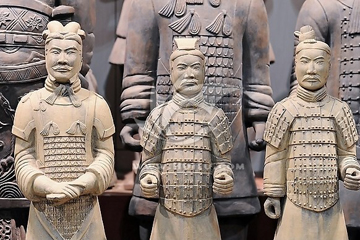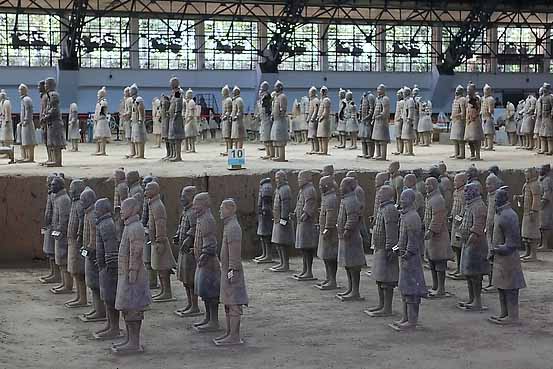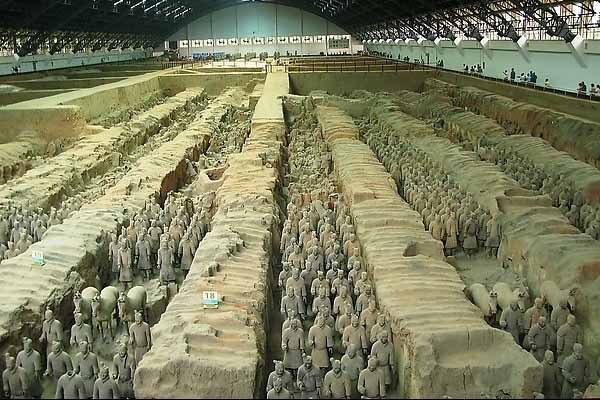Home > Attractions >
Terracotta Warriors
Terracotta Warriors in Xi'an is one of the famous must-see attractions along the silk road; it enjoys an excellent international reputation nominated as the eight wonders of the world. If it was not accidentally discovered by a local peasant, who was drilling a well in 1974, the Qin Terracotta might have remained forgotten. What they found has excited the whole archaeology world.
First, we'll visit Emperor Qin's Tomb, and then visit the three pits
For archaeological fans, Emperor Qin's Tomb represents a glorious and brutal history that can be described as an underground palace. Many years ago, Han dynasty historian Sima Qian detailed the construction effort wrote of the vast effort required to build the emperor's final resting place in "Historical Records." Meanwhile, more than 700,000 laborers have involved to built the tomb to hold the numerous treasures and some valuables that Emperor Qin needed in his afterlives, such as soldiers, concubines, servants, and artisans who worked on the mausoleum lest they reveal its secrets.
Pit 1 is the largest and contains about 6,000 warriors with war chariots and horses. Housed in a gigantic building that resembles an airplane hangar, the warriors are protected from the elements and tourists who view them from elevated walkways. The warriors are lined in 38 trenches, and they are facing eastwards to the emperor's tomb.
Pit 2 shows signs of fire dam. Due to the age, the wooden roof structure was burned when XiangYu looted the mausoleum. While the first pit contains mostly foot soldiers, the second pit is the army's mobile arm with chariots, cavalry, and archers. A tall statue thought to be a general was also found in this pit.
Pit 3 is the command center for the army, with 68 statues of officers around a war chariot. The officers' clothing differs from ordinary soldiers: the officers wear beautiful robes and are much taller.
Bronze Chariots Exhibition Hall: There's a display hall with two bronze chariots unearthed near the base of the emperor's tomb These elaborate half-sized chariots are intricately detailed. With drivers and horses sporting decorated plumes and gold and silver inlaid harnesses. These richly decorated chariots feature working parts such as windows that open and close and turning handles. There are also exhibitions featuring artifacts from the pits allowing a closer look at the intricate artistry.
2. Take the tour line 5 (306), 915, and 914 at the East Square of Xi'an Railway Station and get off at Terracotta Warriors Station.
3. Take metro line 2 from Xi'an North Railway Station to Beidajie, then change to metro 1 to Fangzhicheng, finally take a tour bus 5 (306) to get there.
Operating Time of the Tour Line 5: 7:00 - 19:00
Fare: CNY 5
Xi'an and Luoyang Impression Tour Xi'an Culture Exploration Tour
What to Visit in Terracotta Warriors?
These figures were made around 2,200 years ago, and I was amazed by the carving sculptures when I was entering this museum-like tour destination. Their facial expression and eyes are vividly sculpted that I was afraid to look at them.First, we'll visit Emperor Qin's Tomb, and then visit the three pits
For archaeological fans, Emperor Qin's Tomb represents a glorious and brutal history that can be described as an underground palace. Many years ago, Han dynasty historian Sima Qian detailed the construction effort wrote of the vast effort required to build the emperor's final resting place in "Historical Records." Meanwhile, more than 700,000 laborers have involved to built the tomb to hold the numerous treasures and some valuables that Emperor Qin needed in his afterlives, such as soldiers, concubines, servants, and artisans who worked on the mausoleum lest they reveal its secrets.
Pit 1 is the largest and contains about 6,000 warriors with war chariots and horses. Housed in a gigantic building that resembles an airplane hangar, the warriors are protected from the elements and tourists who view them from elevated walkways. The warriors are lined in 38 trenches, and they are facing eastwards to the emperor's tomb.
Pit 2 shows signs of fire dam. Due to the age, the wooden roof structure was burned when XiangYu looted the mausoleum. While the first pit contains mostly foot soldiers, the second pit is the army's mobile arm with chariots, cavalry, and archers. A tall statue thought to be a general was also found in this pit.
Pit 3 is the command center for the army, with 68 statues of officers around a war chariot. The officers' clothing differs from ordinary soldiers: the officers wear beautiful robes and are much taller.
Bronze Chariots Exhibition Hall: There's a display hall with two bronze chariots unearthed near the base of the emperor's tomb These elaborate half-sized chariots are intricately detailed. With drivers and horses sporting decorated plumes and gold and silver inlaid harnesses. These richly decorated chariots feature working parts such as windows that open and close and turning handles. There are also exhibitions featuring artifacts from the pits allowing a closer look at the intricate artistry.
Opening Hours & Admission Fee
| Opening Hours | 09:00 - 16:00 |
| Admission Fee | CNY 120 |
| Battery Powered Cart | CNY 5/one-way |
| Recommended Time For a Visit | 3 - 5 Hours |
The Manufacturing Process of Terracotta Warriors:
Most terracotta warriors and horses are made by smelting and sintering, with uniform fire, pure color, and high hardness. The manual work it quite strict, because the original terracotta army and horses all had bright paintings. But, during the excavation process, some terracotta figurines still retained a bright color when they were unearthed. However, due to oxidation after excavation. However, the color will disappear in less than ten seconds due to oxidation after excavation. Now you could only see the traces of painting.Climate & Weather of Terracotta Warriors in Xi'an:
Xi'an has a warm temperate semi-humid continental monsoon climate with four distinct seasons. The annual average temperature is 13. 0 ℃ ~ 13. 7 ℃, the coldest average temperature in January -1.2 ℃ ~ 0. 0 ℃, the hottest average temperature in July is 26.3 ℃ ~ 26. 6 ℃. From March to October is the best time to visit Terracotta Warriors. Among them, Xi'an is famed for its annual festivals; one of the livelier ones is the Silk Road International Tourism Festival. Every September, people gather in downtown Xi'an for this event. Fireworks, folk music, and dance performances, talent shows, cultural exhibitions are all part of the itinerary.Annual Temperature of the Year/℃ ( High-Low )
| Jan. | Feb. | Mar. | Apr. | May. | Jun. |
| 5/-3 | 7/-2 | 13/3 | 18/8 | 25/14 | 30/18 |
| Jul. | Aug. | Sept. | Oct. | Nov. | Dec. |
| 32/23 | 33/23 | 28/19 | 22/14 | 8/1 | 3/0 |
How to Get to Terracotta Warriors?
1. Take metro line 1 to the terminal stop Fangzhicheng. There are tour line 5 (306) to the Terracotta Warriors.2. Take the tour line 5 (306), 915, and 914 at the East Square of Xi'an Railway Station and get off at Terracotta Warriors Station.
3. Take metro line 2 from Xi'an North Railway Station to Beidajie, then change to metro 1 to Fangzhicheng, finally take a tour bus 5 (306) to get there.
Operating Time of the Tour Line 5: 7:00 - 19:00
Fare: CNY 5
Related Articles & Posts
Xi'an City Wall Big Goose PagodaXi'an and Luoyang Impression Tour Xi'an Culture Exploration Tour






